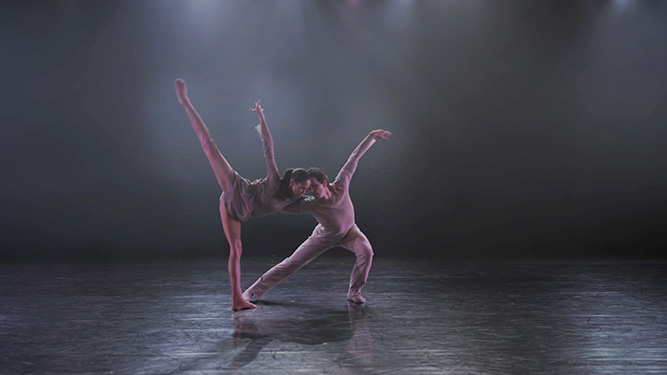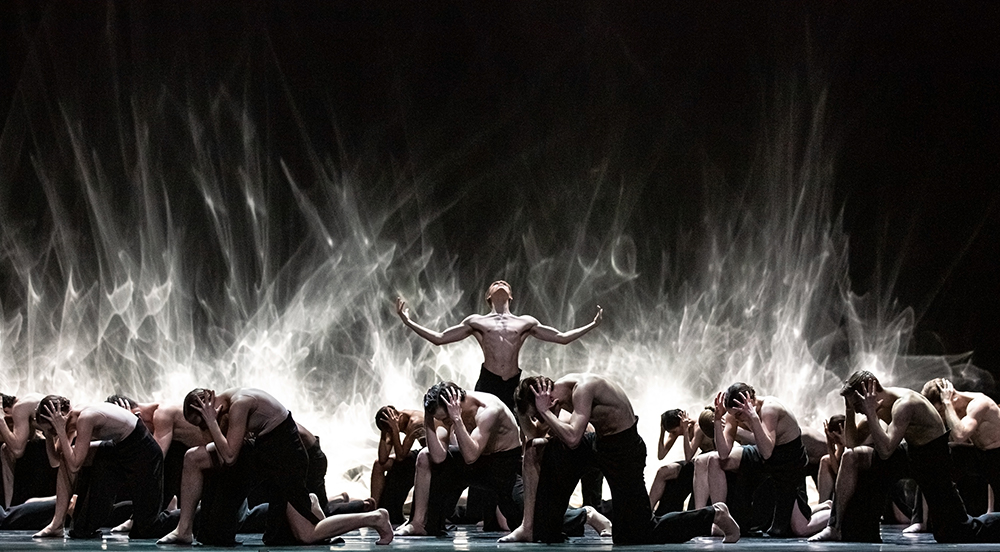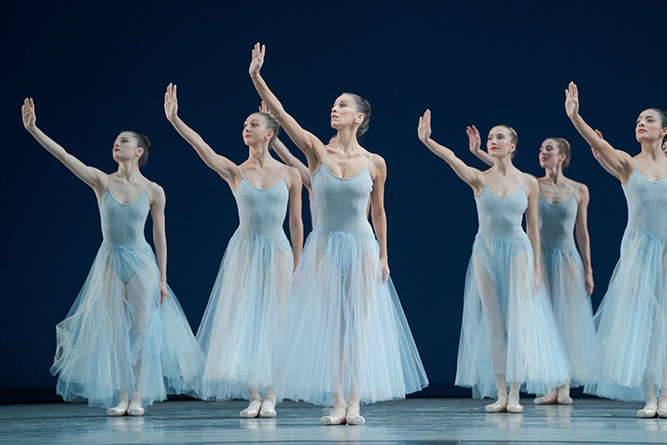Angels’ Atlas
Overview
Canadian choreographer Crystal Pite created Angels’ Atlas for The National Ballet of Canada in March 2020 to rapturous reviews. The ballet unfolds against a morphing wall of light that carries the illusion of depth and a sense of the natural world. Here, the dancing body becomes a sign of humanity’s impermanence and – equally – its vitality within a vast, unknowable world.
Set to original music by Owen Belton and choral pieces by Pyotr Ilyich Tchaikovsky and Morten Lauridsen, Angels’ Atlas is a profound new work from one of the world’s leading contemporary choreographers.
Crystal Pite: Inside the Studio
Crystal Pite: Inside the Studio
5 Things About Crystal Pite
5 Things About Crystal Pite
Five Things to Know
- 1The impetus for Angels’ Atlas came from Crystal Pite’s partner and set designer Jay Gower Taylor who worked with lighting designer Tom Visser to develop an analog method of manipulating reflective light to create complex, painterly images.
- 2A quote from writer and critic Max Wyman about dance greatly inspired Pite: “No other artform speaks so directly about the fragile, temporary quality of life, or about the human instinct to transcend those bonds and aim for that perfect moment of self-realization.”
- 3Pite wanted Angels’ Atlas to evoke “a fierce pulse of life.” She achieves this in part through the score, which includes electronic music by her longtime collaborator Owen Belton featuring samples of clicking sounds, voices, bells and a heartbeat.
- 4Two ethereal choral works bookend Belton’s score: Tchaikovsky’s liturgical Hymn of the Cherubim and Morten Lauridsen’s contemporary work, O Magnum Mysterium. Pite chose vocal works in part because they are tied so irrevocably to the body.
- 5Angels’ Atlas won two Dora Mavor Moore Awards in 2020: Crystal Pite for Outstanding New Choreography and Jay Gower Taylor for Outstanding Achievement in Design.
The Choreographer
A former dancer with Ballet British Columbia and Ballett Frankfurt under William Forsythe, Crystal Pite is now a leading contemporary choreographer. She is Associate Choreographer of Nederlands Dans Theater, Associate Dance Artist of Canada’s National Arts Centre and Associate Artist at Sadler’s Wells, London. Her company, Kidd Pivot, performs her original creations around the world.
The Composers
Canadian composer Owen Belton incorporates a range of acoustic and electronic instruments in his music together with found or common sounds. His many scores for dance have been performed by Kidd Pivot, Ballett Frankfurt and Nederlands Dans Theater, among others. Belton also performs as a singer-songwriter with the band Lost Hombre.
Morten Lauridsen is an American composer of choral music, former Composer-in-Residence of the Los Angeles Master Chorale (1994 – 2001) and professor of composition at the University of Southern California Thornton School of Music. In 2007, he received the National Medal of Arts for “radiant choral works combining musical beauty, power and spiritual depth.”
The late 19th century Russian composer Pyotr Ilyich Tchaikovsky created some of the most popular works in the classical repertoire, particularly his three full-length scores for ballet: Swan Lake, The Sleeping Beauty and The Nutcracker. His body of work includes full-length operas, multiple symphonies and concertos.
Read More
Five Things About Crystal Pite
Reviews
“Human yearning is evoked powerfully onstage… Crystal Pite has a gift for bringing out the very best in dancers.” — Toronto Star
“A glimpse into the infinite... Angels’ Atlas explores the human condition to rapturous choral music and ingenious lighting design.” — The Globe and Mail
“Pite has created another masterpiece.” — Ludwig van Toronto
Serenade
Overview
Created in 1934, Serenade was George Balanchine’s first original ballet created in the US and one of many he set to the music of his beloved composer Tchaikovsky, in this case the beautiful, mournful Serenade for Strings, Op. 48. Today, Serenade is an iconic Balanchine work, especially for its unforgettable opening scene – an ensemble of women standing together, heads turned, one arm raised to the sky.
Five Things to Know
- 1George Balanchine created Serenade for students at the School of American Ballet, an institution he co-founded with Lincoln Kirstein and Edward Warburg, and was first performed at the estate of Felix Warburg in White Plains, New York on June 10, 1934. Intended as a lesson for students, Serenade is now a signature work of New York City Ballet, the company Balanchine directed until his death in 1983.
- 2Balanchine reworked Serenade throughout his career and changed the costumes numerous times before choosing Barbara Karinska’s iconic blue tutus in 1952. Originally the dancers wore tunics and in another design they wore hats.
- 3The National Ballet of Canada first performed Serenade in 1962, introducing the company and its audiences to one of Balanchine’s pivotal works when he was still at the helm of New York City Ballet and very much a modern choreographer.
- 4One of the most striking elements of Serenade as it exists today was not part of the original version. Balanchine decided many years later, while working with the female leads, that the women should dance with their hair loose in the final movement.
- 5Music is everything in a Balanchine ballet and particularly so in Serenade, where Tchaikovsky’s score sets the mood and impels the movement. Balanchine has said, “The only story is the music’s story, a serenade, if you like, in the light of the moon.”
The Choreographer
Born in St. Petersburg, George Balanchine, co-founder and director of New York City Ballet, is one of the most renowned and prolific choreographers of the 20th century. He is credited with revolutionizing the look of classical ballet for a new era in works of unprecedented musicality and aesthetic brilliance.
The Composer
The late 19th-century Russian composer Pyotr Ilyich Tchaikovsky created some of the most popular works in the classical repertoire, particularly his three full-length scores for ballet: Swan Lake, The Sleeping Beauty and The Nutcracker. His body of work includes full-length operas, symphonies and concertos.
Reviews
“Exquisitely captured by the mostly female Corps de Ballet who demonstrated just how strong the National [Ballet]’s women are.” — The Globe and Mail
“Undiminished by the 70 years that have passed since its creation… thanks, in no small part to the skill and devotion brought to the work by the artists of The National Ballet of Canada” — Toronto Star
“One of the masterpieces of 20th century ballet” — Toronto Star
Tanya Howard and Guillaume Côté in Soul.
Video Interlude: Soul
In lieu of intermission, the National Ballet will screen Soul, a beautiful work created for film by Canadian choreographer Jera Wolfe for the company’s virtual season in 2020/21. Soul explores the insular beauty of personal relationships through two duets set to the same piece of music, All Human Beings by Max Richter. The film, directed by Paul McNulty, was edited to show only half of each six-minute duet, leaving the remainder of the choreography unseen. This reinforces Wolfe’s theme that every relationship is a world unto itself and can never truly be known from the outside. This poetic film features Principal Dancer Guillaume Côté and First Soloist Tanya Howard, and Principal Dancers Harrison James and Ben Rudisin.
Ballet Talk
Running Time
- Serenade 33m
- Soul (film) 10m
- Angels' Atlas 27m
- Total (approx) 1h 18m
Credits
Angels’ Atlas
Choreography:
Crystal Pite
Original Music:
Owen Belton
Additional Music:
Pyotr Ilyich Tchaikovsky, Liturgy of St. John Chrysostom, Opus 41, No. 6: Cherubic Hymn
Morten Lauridsen, O Magnum Mysterium
Reflective Light Backdrop Concept:
Jay Gower Taylor
Reflective Light Backdrop Design:
Jay Gower Taylor and Tom Visser
Lighting Design:
Tom Visser
Costume Design:
Nancy Bryant
Assistant to the Choreographer:
Spencer Dickhaus
Premiere: The National Ballet of Canada, Four Seasons Centre for the Performing Arts, Toronto, February 29, 2020
Produced and commissioned by The National Ballet of Canada.
A co-production of The National Ballet of Canada and Ballett Zürich.
Philanthropic support for Angels’ Atlas is generously provided by An Anonymous Donor, Rosamond Ivey, Ira Gluskin & Maxine Granovsky Gluskin, The Producers’ Circle, The Volunteer Committee of The National Ballet of Canada and The Gail Hutchison Fund.
The Producers’ Circle: Gail & Mark Appel, John & Claudine Bailey, Inger Bartlett & Marshal Stearns, Laura Dinner & Richard Rooney, Gail Drummond & Bob Dorrance, The Thor E. and Nicole Eaton Family Charitable Foundation, Sandra Faire & Ivan Fecan, Kevin Garland & Roger Garland, C.M., Ira Gluskin & Maxine Granovsky Gluskin, The William & Nona Heaslip Foundation, Anna McCowan Johnson & Donald K. Johnson, O.C., Judy Korthals & Peter Irwin, Mona & Harvey Levenstein, Jerry & Joan Lozinski, The Honourable Margaret Norrie McCain, C.C., Julie Medland, Sandra Pitblado & Jim Pitblado, C.M., The Harry & Lillian Seymour Family Foundation, Gerald Sheff & Shanitha Kachan and The Jack Weinbaum Family Foundation.
Serenade
Choreography:
George Balanchine
Staged by:
Joysanne Sidimus
Music:
Pyotr Ilyich Tchaikovsky, Serenade for Strings, Op. 48
Costume Design:
Barbara Karinska
Lighting Design:
Ronald Bates
Premiere: American Ballet, Adelphi Theater, New York City, March 1, 1935
The National of Canada Ballet Premiere: North Texas State University, Denton, TX, October 17, 1962
The performance of Serenade, a Balanchine® Ballet, is presented by arrangement with The George Balanchine Trust and has been produced by arrangement with the Balanchine Style® and Balanchine Technique® Service standards established and provided by the Trust.
Soul
Choreography:
Jera Wolfe
Music:
All Human Beings, Performed by Max Richter, Kiki Layne & Mari Samuelsen
Courtesy of Decca Records, under exclusive license from Universal Music Canada Inc.
Costume Design:
Wardrobe Department, Stacy Dimitropoulos, Wardrobe Supervisor
Lighting Design:
Jeff Logue
Répétiteur:
Rex Harrington, O.C.
Running Time
- Serenade 33m
- Soul (film) 10m
- Angels' Atlas 27m
- Total (approx) 1h 18m
Email Newsletter
Be the first to know when casting is announced by signing up for Ballet News.

